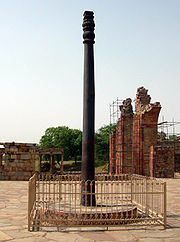The iron pillar of Delhi, India is a 7 meter (22 feet) high pillar in the Qutb complex which is notable for the composition of the metals used in its construction.
The pillar—almost seven meters (22 feet) high and weighing more than six tons—is said to have been fashioned at the time of Chandragupta II Vikramaditya (375–413), though other authorities give dates as early as 912 BCE.[2] The pillar initially stood in the centre of a Jain temple complex housing twenty-seven temples that were destroyed by Qutb-ud-din Aybak, and their material was used in building the Qutub Minar and Quwwat-ul-Islam mosque. The pillar and ruins of the temple stand all around the Qutb complex today. The pillar is 98% pure wrought iron, and is a testament to the high level of skill achieved by ancient Indian ironsmiths. It has attracted the attention of both archaeologists and metallurgists, as it has withstood corrosion for over 1600 years in the open air.
The name of the city of Delhi is thought to be based on a legend associated with the pillar ...Description
The pillar, almost seven meters high and weighing more than six tons, was erected by Chandragupta II Vikramaditya (375 CE–414 CE), (interpretation based on analysis of archer type Gupta gold coins) of the Gupta dynasty that ruled northern India 320–540. The pillar with the statue of Chakra at the top was originally located at a place called Vishnupadagiri (meaning “hill with footprint of Lord Vishnu”). This has been identified as modern Udayagiri, situated in the vicinity of Besnagar, Vidisha and Sanchi. These towns are located about 50 kilometres east of Bhopal, in central India. There are several aspects to the original site of the pillar at Udayagiri. Vishnupadagiri is located on the Tropic of Cancer and, therefore, was a centre of astronomical studies during the Gupta period. The Iron Pillar served as a sundial when it was originally at Vishnupadagiri. The early morning shadow of the Iron Pillar fell in the direction of the foot of Anantasayin Vishnu (in one of the panels at Udayagiri) only around the summer solstice (June 21). The Udayagiri site in general, and the Iron Pillar location in particular, are evidence for the astronomical knowledge that existed in Gupta India.
The pillar bears a Sanskrit inscription in Brahmi script which states that it was erected as a standard in honour of Lord Vishnu. It also praises the valor and qualities of a king referred to simply as Chandra, who has been identified with the Gupta King Chandragupta II Vikramaditya (375-413). The inscription reads (in the translation given in the tablets erected by Pandit Banke Rai in 1903):
He, on whose arm fame was inscribed by the sword, when, in battle in the Vanga countries (Bengal), he kneaded (and turned) back with (his) breast the enemies who, uniting together, came against (him);-he, by whom, having crossed in warfare the seven mouths of the (river) Sindhu, the Vahlikas were conquered;-he, by the breezes of whose prowess the southern ocean is even still perfumed;-(Line 3.)-He, the remnant of the great zeal of whose energy, which utterly destroyed (his) enemies, like (the remnant of the great glowing heat) of a burned-out fire in a great forest, even now leaves not the earth; though he, the king, as if wearied, has quit this earth, and has gone to the other world, moving in (bodily) from to the land (of paradise) won by (the merit of his) actions, (but) remaining on (this) earth by (the memory of his) fame;- (L. 5.)-By him, the king,-who attained sole supreme sovereignty in the world, acquired by his own arm and (enjoyed) for a very long time; (and) who, having the name of Chandra, carried a beauty of countenance like (the beauty of) the full-moon,-having in faith fixed his mind upon (the god) Vishnu, this lofty standard of the divine Vishnu was set up on the hill (called) Vishnupada.
It is believed by some that the pillar was installed in its current location by Vigraha Raja, the ruling Rajput Tomar king. One of the inscriptions on the iron pillar from A.D. 1052 mentions Rajput king Anangpal II.
Made up of 98% pure wrought iron, it is 7.21m (23 feet 8 inches) high, with 93 cm (36.6 inches) buried below the present floor level, and has a diameter of 41 cm (16 inches) at the bottom which tapers towards the upper end. The pillar was manufactured by forge welding. The temperatures required to form such a pillar by forge welding could only have been achieved by the combustion of coal.[citation needed] The pillar is a testament to the high level of skill achieved by ancient Indian iron smiths in the extraction and processing of iron.
A fence was erected around the pillar in 1997 in response to damage caused by visitors. There is a popular tradition that it was considered good luck if you could stand with your back to the pillar and make your hands meet behind it.
Scientific analysis
In a report published in the journal Current Science, R. Balasubramaniam of the IIT Kanpur explains how the pillar's resistance to corrosion is due to a passive protective film at the iron-rust interface. The presence of second phase particles (slag and unreduced iron oxides) in the microstructure of the iron, that of high amounts of phosphorus in the metal, and the alternate wetting and drying existing under atmospheric conditions, are the three main factors in the three-stages formation of that protective passive film.
Lepidocrocite and goethite are the first amorphous iron oxyhydroxides that appear upon oxidation of iron. High corrosion rates are initially observed. Then an essential chemical reaction intervenes: slag and unreduced iron oxides (second phase particles) in the iron microstructure alter the polarization characteristics and enrich the metal–scale interface with P, thus indirectly promoting passivation of the iron (cessation of rusting activity). The second phase particles act as a cathode, and the metal itself serves as anode, for a mini-galvanic corrosion reaction during environment exposure. Part of the initial iron oxyhydroxides is also transformed into magnetite, which somewhat slows down the process of corrosion. But the ongoing reduction of lepidocrocite, and the diffusion of oxygen and complementary corrosion through the cracks and pores in the rust, still contribute to the corrosion mechanism from atmospheric conditions.
The next main agent to intervene in protection from oxidation is phosphorus, enhanced at the metal–scale interface by the same chemical interaction previously described between the slags and the metal. The ancient Indian smiths did not add lime to their furnaces. The use of limestone as in modern blast furnaces yields pig iron that is later converted into steel; in the process most phosphorus is carried away by the slag. The absence of lime in the slag, and the deliberate use of specific quantities of wood with high phosphorus content (for example Cassia auriculata) during the smelting, induces a higher P content (> 0.1%, average 0.25%) than in modern iron produced in blast furnaces (usually less than 0.05 per cent). There is also more phosphorus as solid solution throughout the metal than in the slags (one analysis gives 0.10% in the slags for 18% in the iron itself, for a total P content of 0.28% in the metal). This high P content and particular repartition are essential catalysts in the formation of a passive protective film of “misawite” (d-FeOOH), an amorphous iron oxyhydroxide that forms a barrier by adhering next to the interface between metal and rust. Misawite, the initial corrosion-resistance agent, was thus named because of the pioneering studies of Misawa and co-workers on the effects of P and Cu and those of alternating atmospheric conditions, in rust formation.
The most critical corrosion-resistance agent is iron hydrogen phosphate hydrate (FePO4-H3PO4-4H2O) under its crystalline form and building up as a thin layer next to the interface between metal and rust. Rust initially contains iron oxide/oxyhydroxides in their amorphous forms. Due to the initial corrosion of metal, there is more P at the metal–scale interface than in the bulk of the metal. Alternate environmental wetting and drying cycles provide the moisture for phosphoric acid formation. Over time the amorphous phosphate is precipitated into its crystalline form (the latter being therefore an indicator of old age, as this precipitation is a rather slow happening). The crystalline phosphate eventually forms a continuous layer next to the metal, which results in an excellent corrosion resistance layer. In 1,600 years the film has grown just one-twentieth of a millimetre thick.
Balasubramaniam states that the pillar is "a living testimony to the skill of metallurgists of ancient India". An interview with Balasubramaniam and his work can be seen in the 2005 article by Veazy.
It was claimed in the 1920s that iron manufactured in Mirjati near Jamshedpur is similar to the iron of the Delhi pillar. Further work on Adivasi (tribal) iron by the National Metallurgical Laboratory in the 1960s did not verify this claim.
According to INTACH, further research has been proposed on the Iron Pillar to study the ancient metallurgy of India. The ASI is reported to have agreed to the proposed studies that would make comparisons by testing other ancient iron objects like the pillar at Dhar, the iron beams at Konarak, and so forth. The present research using non-intrusive technique as proposed by Dr.Baldev Raj who is the Director of the Indira Gandhi Centre for Atomic Research and a member of the panel of architects and scientists.




0 Comments:
Post a Comment